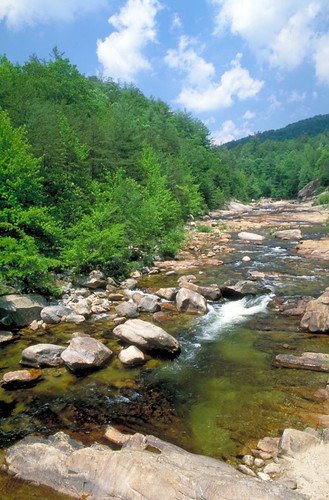
Planning for the future of the nation’s water resources is more important now than ever before as severe drought grips the West, affecting heavily populated areas and critical agricultural regions. Forests generally yield huge quantities of water—much more than crops or grasslands—but also use a lot of water during the growing season, so some land managers wonder if forest thinning could boost water supplies to people and ecosystems in a changing climate.
U.S. Forest Service researchers from the Eastern Forest Environmental Threat Assessment Center and the Coweeta Hydrologic Laboratory tested this idea and found that the results were not so cut and dried. Their findings were recently published in a special issue* of the journal Hydrological Processes.
The researchers examined how water yield could change with various levels of forest thinning based on reductions in Leaf Area Index (LAI)—the ratio of leaves per unit of ground area, which provides a measure of forest productivity and water use. The researchers considered the effects of LAI reduction in the context of climate and used the Water Supply Stress Index (WaSSI) model to simulate water yields based on combined changes in LAI, temperature and precipitation as well as four future climate scenarios across 2,100 U.S. watersheds.
Model results indicate that thinning could increase water yield, but LAI reduction and water gains are not proportional. Even with substantial thinning, water yield increases were relatively minimal. “As a whole across the United States, water yield could increase by 3 percent, 8 percent and 13 percent if LAI is reduced by 20 percent, 50 percent and 80 percent, respectively,” says Ge Sun, Eastern Threat Center research hydrologist and the study’s lead author.
Changes in temperature and precipitation also have profound effects on water yield due to their influence on evapotranspiration—the combination of evaporation and water uptake through roots. “Temperature increases of 2 degrees Celsius (3.6 degrees Fahrenheit) could increase forest water use and decrease water yield by 11 percent. If precipitation is reduced by 10 or 20 percent, forest water yields could decrease by 20 or 39 percent, respectively,” says Sun.
In already wet or moderately wet areas of the country, forest thinning could lead to greater increases in water yield compared to drier areas. But since these increases in water yield are directly related to precipitation trends, excessive forest thinning could lead to flooding.
In dry areas where water is needed most, managers may thin forests to reduce wildfire risk, which could make soil water more available to remaining trees and improve overall forest heath. Any increases in water yield could be an added bonus in some cases. Still, researchers are challenged to project water yield as future climate change could lead to significant shifts in forest dynamics. The historically water-rich South, for example, is becoming drier—a trend that is expected to continue over the next several decades.
Uncertainty is an inherent part of planning, especially in the face of climate change, but managers should remain vigilant to sustain forests and their critical services.
“Mitigating and adapting to climate change impacts on forest water supplies will require innovative management approaches, which could include thinning. But forest managers must preserve forest values and balance the tradeoffs among water quantity, quality, carbon sequestration, management costs and other benefits and concerns,” says Sun. “Now and in the future, active conservation and management efforts are critical to protect our forests, which are the main sources of clean water for many metropolitan areas and aquatic ecosystems.”
*This special issue of Hydrological Processes includes research presented at the 3rd International Conference on Forests and Water in a Changing Environment held in Fukuoka, Japan in 2012.
